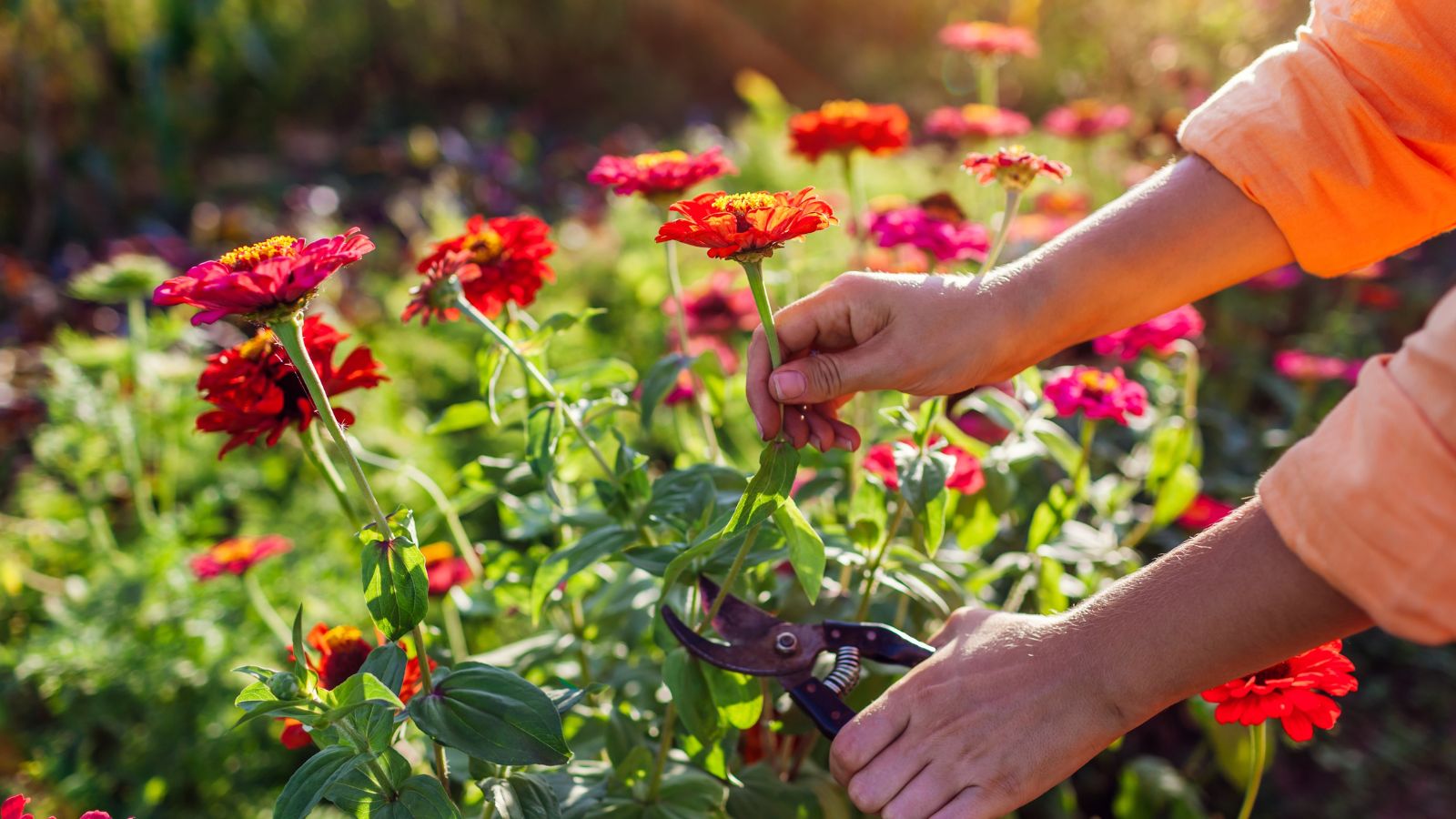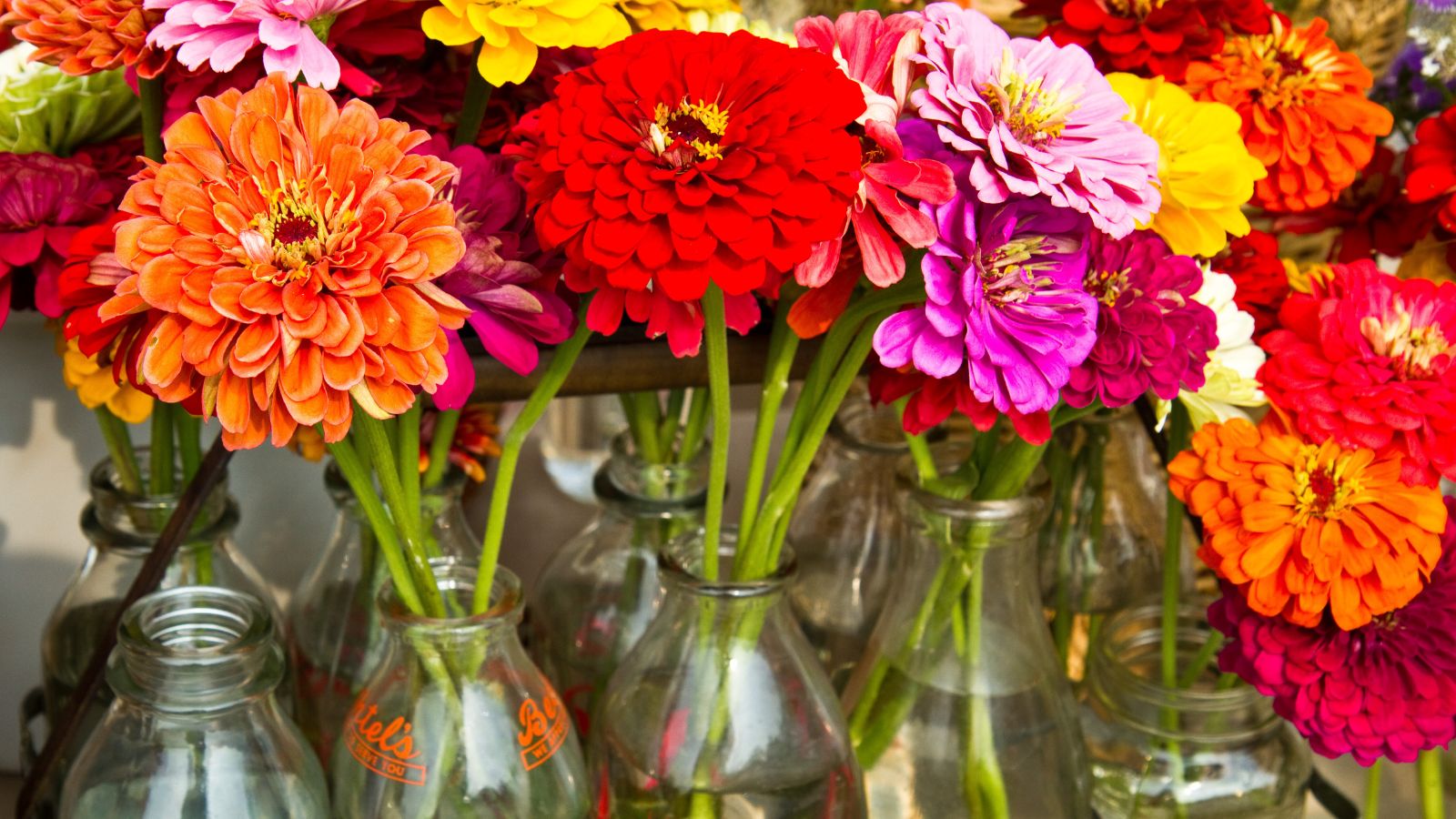PROTECT YOUR DNA WITH QUANTUM TECHNOLOGY
Orgo-Life the new way to the future Advertising by AdpathwayIf you’re considering a cutting garden, there are a handful of flowers that I recommend as must-haves. While I love all the fancy dahlias and airy, delicate cosmos, it’s zinnias that I will plant every year. There is something about a cut zinnia bouquet that always delivers happiness.
Zinnias are easy to grow and bloom quickly. Once they get started, one plant can produce dozens of flowers if you keep up with them properly. They also have a substantial vase life. They will last approximately 10 days in a vase if you keep the water fresh and avoid exposing them to direct sunlight.
As meaningful as aftercare is, such as managing water and sun exposure, the way you snip them also makes a difference. From the time of day to the location of your cuts, several factors influence the longevity of your flowers. Here are some tips I’ve learned if you want to cut zinnia flowers for a bouquet.
Cut Early and Often
 Harvest them regularly to encourage more blooms.
Harvest them regularly to encourage more blooms.It takes about two months for zinnias to produce their first flower. Some larger varieties take longer, and some small ones can bloom in as few as 50 days. My answer to when you should start harvesting them is right away.
Those first flowers may be smaller than you hoped, but if you snip them early, the next flowers will be larger. There will also be more of them. Zinnias are a cut-and-come-again type of plant. The more you prune them, the more they will branch. The more branches, the more blooms.
[div]
Cut zinnia flowers for your bouquets as soon as the first blooms appear. Going forward, harvest them often. It’s fine to leave a few on the plant for pollinators. But if these are specifically for cutting, they will perform best if you continuously harvest them when they are ready.

Wait for Open Flowers and Stiff Stems
 Don’t harvest them while still budding; wait for open blooms.
Don’t harvest them while still budding; wait for open blooms.Some flowers are best harvested ‘in the bud,’ which means that you should cut them before the flowers open. For flowers like ranunculus and peonies, this guarantees a longer vase life. You do this with any flower that will continue to open after you cut it.
[/div]
Zinnias are not one of those flowers that will continue to open after you snip them. Whatever the stage of opening you cut them in, this is where they will generally remain. For this reason, it’s best to wait until they are fully open before harvesting them.
Another test to see whether they are ready to harvest is the stiffness of their stems. You want to cut flowers with strong, stiff stems. Zinnia stems are hollow, and if you pinch them or snip them wrong, you’ll break them and end up with a floppy flower.
This stem factor applies mainly to the larger flowers that grow at the top of the plant. As your zinnias branch more, you will see smaller, thinner branches with smaller flowers that don’t stand up well. These don’t make great cut flowers.
Cut At the Right Time Of Day
 Morning is the best time to cut zinnia flowers for bouquets.
Morning is the best time to cut zinnia flowers for bouquets.The time of day when you cut your zinnias is an essential factor in their longevity. You may notice, on warmer days, that your zinnias look less perky in the afternoon. This is a sign of dehydration, as sunlight and heat cause plants to lose water more quickly.
Most plants are best hydrated in the early morning. However, many will perk back up in the evening. Either time is acceptable, but I recommend harvesting in the morning for the freshest, longest-lasting blooms.
In the morning, your plants have had time to recover from the stress that heat produces from the day before. They are at their freshest, and this is the best time to cut your zinnias for bouquets, as they will last longest if cut in this state.
 Sharp, sanitized snips are the key to successful harvests.
Sharp, sanitized snips are the key to successful harvests.If you’re going to grow flowers for cutting, it’s important to have a solid tool for making your cuts. I prefer to use sharp harvesting snips. The small, sharp blades and spring action make it easy to make clean cuts.
You may be more comfortable with scissors, or even pruners. Pruners are a bit heavy for zinnias, but they work well on larger plants, such as sunflowers and peonies. Whichever one you are comfortable with, have a designated tool that you use for this purpose.
Keep this tool clean and sharp to avoid jagged cuts and the potential for transferring bacteria. This can shorten the life of your entire bouquet. Bacteria on the stems means bacteria in the water.
[div]
I prefer to clean my harvesting snips right after I use them. This helps take the guesswork out when I’m ready to use them again. Wipe them down with alcohol or a solution of bleach and water to keep them in tip-top condition.

Make the Right Cuts
 Be sure to snip at an angle just above a node.
Be sure to snip at an angle just above a node.Where you make your cuts and how are also helpful factors in extending the life of the zinnias you cut for bouquets. These things also influence the growth habit and continued production of your plants.
[/div]
The best place to snip your stems is just above a node. You want to trim as far back as you can without removing another branch. The longer the stem, the better it is for the plant’s structure. Cutting back as far as possible encourages branching, resulting in a more vigorous and bushy plant.
Trace your stem all the way to the first node with a bud that has already begun to grow. This is the spot where a new branch will form and produce a new flower. Cut just above that connecting at the node.
Make your cuts angled, or at a diagonal. This creates a larger surface area for the stem to absorb water. More water means your zinnia bouquets will last longer. It also helps the plant because water won’t pool on that diagonal cut and cause fungus.
Bring Water
 Put them in water ASAP.
Put them in water ASAP.There are two integral items that you should bring to the cutting garden with you. The first is a clean, sharp tool. The other is a jar or container of clean, cool water to place your zinnias directly into after cutting.
The sooner you get your stems in water, the more readily they will absorb it. When the stem dries out, it begins to form a blockage that inhibits the intake of water. Placing those stems in water right away will eliminate the possibility of creating this blockage. Your stems will simply draw in fresh water and continue to look hydrated and beautiful.
Fresh Cuts and Fresh Water
 Refresh the water every two to three days for the longest lasting arrangement.
Refresh the water every two to three days for the longest lasting arrangement.Finally, before assembling your zinnia bouquet, make fresh cuts to the stems. Even if you put them directly in water after cutting, there is no harm in snipping off a bit more of that stem.
Additionally, your flowers will absorb more water on that first day than at any other time. Make sure to check the water level the next day and ensure that the ends of every stem are still submerged.
This may seem like the end of the story, but if you want that zinnia bouquet to last, don’t stop here. To extend the life of any cut flower, it’s essential to refresh the water every two to three days.
What do I mean by giving them a refresh? Simple! Every two to three days, replace the old water with fresh. Every time you do this, take a small snip off the bottom of the stems to once again expose tissue that is receptive to absorbing water.


 2 weeks ago
10
2 weeks ago
10





















 English (US) ·
English (US) ·  French (CA) ·
French (CA) ·